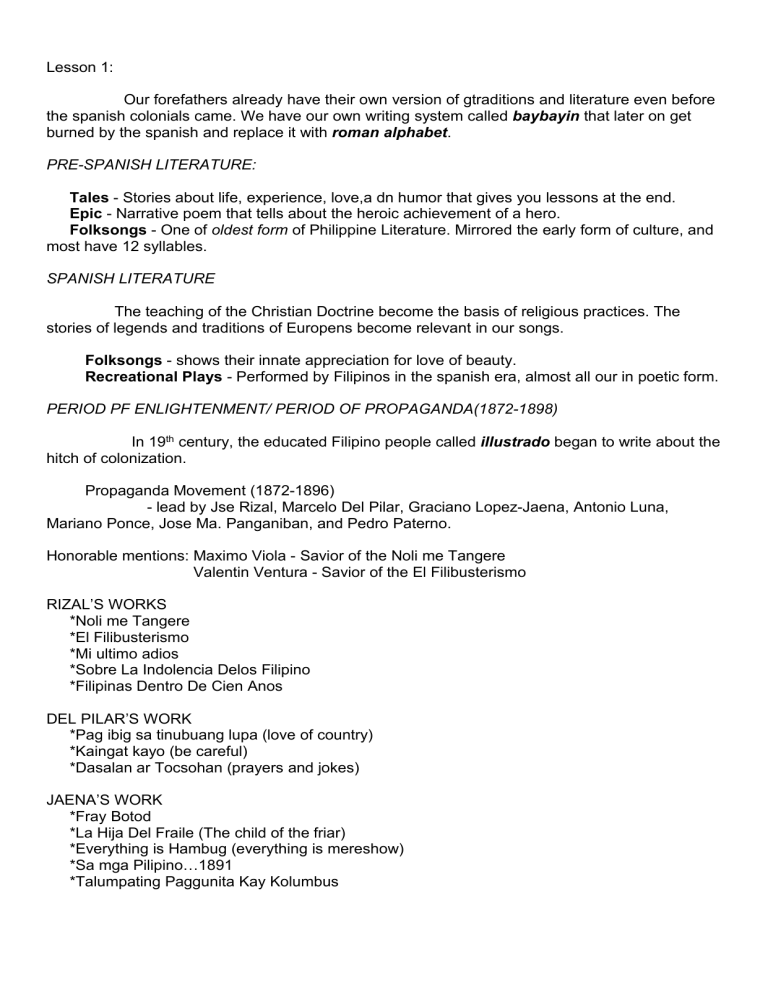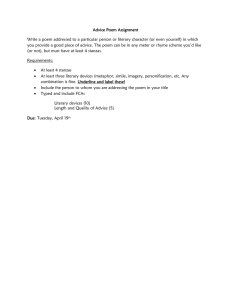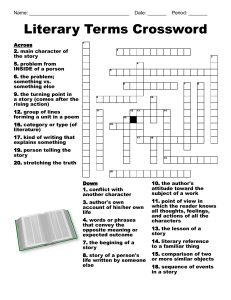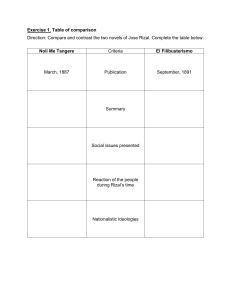
Lesson 1: Our forefathers already have their own version of gtraditions and literature even before the spanish colonials came. We have our own writing system called baybayin that later on get burned by the spanish and replace it with roman alphabet. PRE-SPANISH LITERATURE: Tales - Stories about life, experience, love,a dn humor that gives you lessons at the end. Epic - Narrative poem that tells about the heroic achievement of a hero. Folksongs - One of oldest form of Philippine Literature. Mirrored the early form of culture, and most have 12 syllables. SPANISH LITERATURE The teaching of the Christian Doctrine become the basis of religious practices. The stories of legends and traditions of Europens become relevant in our songs. Folksongs - shows their innate appreciation for love of beauty. Recreational Plays - Performed by Filipinos in the spanish era, almost all our in poetic form. PERIOD PF ENLIGHTENMENT/ PERIOD OF PROPAGANDA(1872-1898) In 19th century, the educated Filipino people called illustrado began to write about the hitch of colonization. Propaganda Movement (1872-1896) - lead by Jse Rizal, Marcelo Del Pilar, Graciano Lopez-Jaena, Antonio Luna, Mariano Ponce, Jose Ma. Panganiban, and Pedro Paterno. Honorable mentions: Maximo Viola - Savior of the Noli me Tangere Valentin Ventura - Savior of the El Filibusterismo RIZAL’S WORKS *Noli me Tangere *El Filibusterismo *Mi ultimo adios *Sobre La Indolencia Delos Filipino *Filipinas Dentro De Cien Anos DEL PILAR’S WORK *Pag ibig sa tinubuang lupa (love of country) *Kaingat kayo (be careful) *Dasalan ar Tocsohan (prayers and jokes) JAENA’S WORK *Fray Botod *La Hija Del Fraile (The child of the friar) *Everything is Hambug (everything is mereshow) *Sa mga Pilipino…1891 *Talumpating Paggunita Kay Kolumbus THE AMERICAN REGIME (1898-1944) -The Americans influenced Filipino writers to use the english language. - Jose Garcia Villa became known for his free verse. - Spanish and Tagalog dialect is still used. THE JAPANESE PERIOD (1941-1945) -The English Literature came to a stop. - Newspaper stop circulating in public. 2 newspaper that is allowed to circulate: Tribune and Philippine Review - Most of the literature shows nationalism. -TYPES OF POEM1. Haiku - 17 syllables, 3 lines (5,7,5) 2. Tanaga - 28 syllables, 4 lines (7,7,7,7) 3. Karaniwang Anyo - usual form with message, meter, and rhyme. PERIOD OF ACTIVISM (1970-1972) - The time of youth and reform. - Literatures shows demand for the government to change. PERIOD OF THE NEW SOCIETY (1972-1980) - Started in Sep. 21, 1972 - Carlos Palanca continued giving awards - Poems are about nature, culture, and customs. - Literature shows the positive side of the Philippines. - Magazines and cosmics. PERIOD OF THE THIRD REPUBLIC (1981-1985) - Poems were romantic and revolutionary. - songs were true to life like poverty,grief, and freedom. POST-EDSA 1 REVOLUTION (1986-1995) - Feb. 21-25, the so-called People power prevailed. - The change is noticed in songs, newspaper, and t.v programs. - Newspaper that started to circulate: The Inquirer, Malaya, People’s Journal. ST 21 CENTURY PERIOD - New trends is used to suit the taste of the new generation. - Has it own and new flavor. LESSON 2: Traditions and Locations: The Filipino Poem BUGTONG - uses talinghaga that actually helped convey the answer to the riddle. SALAWIKAIN - proverbs used to express pieces of wisdom or beliefs important to Filipino society .EPIKO - long episodic, chanted poems telling story, normally about legendary heroes and their adventures, often contending with and being aided by supernatural creature PHILIPPINE PRE-COLONIAL LITERATURE PROVERBS - practical observations and philosophy of everyday life that are written usually in a rhythmic scheme. EXAMPLE: kung ano ang puno, siya ang bunga RIDDLES - they demand an answer and are used to test the wits of those who are listening to them. EXAMPLE: heto na si kaka, bubuka - bukaka FOLKSONGS - beautiful songs that are informal expressions of our ancestors experiences in life. EXAMPLE: paru-parong bukid TALES - stories of origin for certain places, their names, and their creation. EXAMPLE: alamat ng pinya EPICS - long wided poems about a hero and his adventures and misadventures. EXAMPLE: the hinilawod SPANISH COLONIAL LITERATURE CORRIDO - is a legendary religious narrative forms that usually details the lives of saints or the history of a tradition. AWIT - a chivalric poem about a hero usually about a saint. • PASYON - a narrative poem about the life of Jesus Christ. CENACULO - the dramatization of the passion of Christ. MORO MORO - also called as Comedia De Capa Y Espada a blood and thunder melodrama depicting the conflict of Christians and Muslims. CARILLO - a play that uses shadows as its own spectacles. TIBAG - is the reenactment of St. Helena's search for the holy cross. DUPLO OR KARAGATAN - native dramas that are connected to Catholic mourning rituals and harvest celebrations. ZARSUELA - probably one of the most famous forms of entertainment back in the Spanish era. Zarsuela are musical comedies or melodramas that deal with the elemental passions of human beings. LESSON 3: IDENTIFYING REPRESENTATIVE TEXTS AND AUTHORS FROM THE REGIONS DOCTRINA CHRISTIANA an early book of roman catholic catchism written in 1593 by Fray Juan de Plasencia, and is believed to be one of the earliest books printed in the Philippines. REGION 1: •Francisco Lopez - Augustinian friar who in 1621, published his own Iloko translation of the Doctrina Christiana; the first book to be printed in Iloko • Leona Florentino - considered as the "National Poetess of the Philippines". - She wrote Nalpay A Namnama o Naunsiyaming Pag-ibig - she is considered as the "Mother of Philippine Women's Literature" and the "Bridge from Oral to Literary Tradition" • Pedro Bucaneg - a Filipino poetry who is blind since birth - "Father of Ilocano Literature" - he is the acknowledged author of the Ilocano epik Biag-Ni-Lam-Ang influenced by the Indian Hindu Ramayana ang Mahabrata. REGION 2: • Ines Taccad Tamayo - Won “ People of Consequences” at Don Carlos Panlacia Memorial Award for literatur in 1970. • Fernando Maramag - was an excellent poet and journalist in English. - Wrote “the Rural Maid”. REGION 3: • Macaria Garcia - she narrated "Suan, the good gueser" and "Suan's good luck • Anicio Pascual - he wrote "Juan Manalaksan" - He is from Arayat Pampanga, who heard the story from an old Pampangan woman REGION 4: • Reyes and Rizal - Manuel Reyes from Rizal narrated "Suan Eket" Jose Rizal wrote "Legend of Maria Makiling" aside from Noli and El Fili REGION 5: • Mariano Perfecto - he published the first Bicol newspaper, "Ang parabareta" - father of bicol literature WESTERN VISAYAS LITERATURE • the Paktakon is a riddle while Harubaton is a proverb • the Panayanon Literature is known for Tungkung Langit and Alunsina REGION 7: • Vicente Sotto - he wrote the first Cebuano literature "Maming" - the father of Cebuano literature REGION 8: • Clodualdo Del Mundo - he wrote the poem "Ang kanyang Mga Mata" LESSON 4: FIVE MAIN GENRES OF LITERATURE 1. POETRY - merely always written in stanzas and lines creating a unique look on the page. 2. DRAMA - any text meant to be performed rather than read. 3. PROSE - any kind of written text that is not poetry 4. NON-FICTION - vast category that is a type of prose that includes many different sub-genres. 5. MEDIA - the newest type of literature that has been defined as a distinct genre -ELEMENTS OF LITERATURE• ELEMENTS OF PLOT - sequence of events of a story which often have a causal relationship with other. • PLOT DEVICES - techniques that the writer uses to creatively presents the events in the story. • FLASHBACK - plot device where the story moves away from the current events happening in the story to a time in the past . • FORESHADOWING - plot device where the story presents an image or a scene which gives the reader clues as to events which will happen in the future. • EXPOSITION - refers to characters introduced, setting, goals, motivations, stakes established. • RISING ACTION - refers to conflicts, struggles, and blocks to the goaI • CLIMAX - the turning point. battle is won or lost. resolution to the conflict occurs or is made possible. • FALLING ACTION - the aftermath or results • RESOLUTION OR DENOUEMENT - refers to the problem, conflict, resolved, enemy vanquished, goal reached. • CHARACTERS - persons who are involved in a story. • POINT OF VIEW - refers to how the story is being told/narrated. • TONE/MOOD - tone refers to the authors attitude while mood is the climate of feeling in a literary work. • SYMBOLISM - refers to a person, place, or object which has meaning but suggests other meaning as well • THEME - main idea or underlying meaning of a literary work. -STRUCTURES OF POETRY• STANZA - group of lines in a poem. it is often called a verse. • RHYME - patterns of words that contain similar sounds. • METER - rhytmic structure of a poem. sometimes you can feel the meter by tapping each syllable • LINE BREAK - where a line of poetry breaks. it causes the reader to pause and will determine how the poem is read. LESSON 5: LITERARY GENRES AND DEVICES >GENRES< 1. Diary - a person’s thoughts and experience everyday. 2. Drama - tells a story through actions and dialogues. 3. Commedy - type of drama that makes the audience laugh. 4. Fiction - Literature written by the imagination of the author. 5. Blog - Regualr thought, experience, and opinions you put in the internet for people to read. >DEVICES< Literary Device is a technique writter uses to produce a special effects in their works. 1. Figure of Speech (Tayutay) - Simile Comparing unlike things with “like” or “as”. - Metaphor Comparing things directly without using “like” or “as”. - Symbolism Use of image, word, event, and even people to convey a different and deeper meaning. - Hyperbola An exaggerated statement not to be taken literary by the reader.




